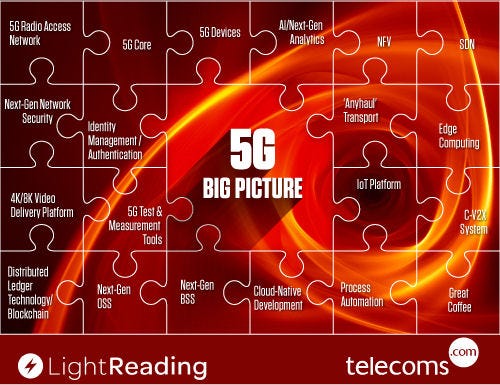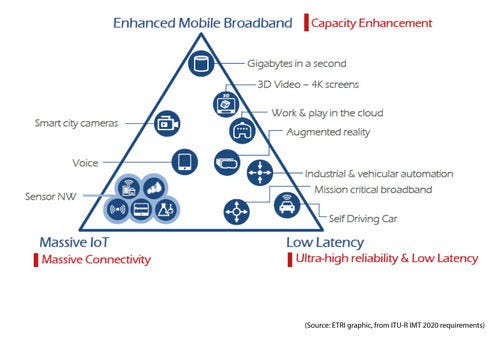5G – more than just a RAN on steroids
The metamorphosis currently underway in the communications networking industry is unprecedented, and many are worried it will turn a functioning (but flawed) industry into something more frightening.
November 5, 2018

By Ray Le Maistre
The metamorphosis currently underway in the communications networking industry is unprecedented, and while for some the evolution to a 5G world is akin to a caterpillar transforming into a butterfly, others are worried it will turn a functioning (but flawed) industry into something more frightening.
Of course, we don’t know how 5G is going to turn out. What we do know, though, is that it’s about much more than some souped-up new devices and a radio access network (RAN) on steroids. And while we are witnessing an increasing number of claims about 5G service ‘firsts’ in the industry, these initial launches are only scratching the surface of what is possible and, importantly, are basing their claims on the deployment of a limited number of next generation networking elements.
And that’s fine for 2018 and 2019 – it’s understandable that for some competitive and marketing reasons, being first with a 5G offer can be important. But what about in 10 years’ time? What technology and operational process advances will be needed to fulfil the full potential of 5G?
In our view, a successful 5G strategy will require network operators to address, in some way, a very broad range of technologies and processes, all of which will play a critical role in enabling them to capitalize on the full potential that a 5G deployment will offer.
All of these are pieces in the Big 5G Picture jigsaw puzzle: Miss, or dismiss, any of the 20 elements, many of which are interdependent, and the picture will be incomplete and opportunities lost. Deploy them together and there just might be something for 5G business case doubters to chew on.
What are these 20 elements? (And yes, that’s a suspiciously round number…)
We’re talking about the likes of SDN and NFV, “anyhaul” transport, edge computing, AI/analytics, IoT and C-V2X platforms and more, as well as the 5G radio access network (RAN), 5G core and devices. Here’s what our 5G Big Picture looks like:

And with each of these elements ultimately playing a critical role in full 5G deployments, that, in turn, is creating new opportunities for (and threats to) the thousands of companies that are aiming to become the technology and professional services partners for the world’s communications network operators.
Many vendors have already shifted to a 5G-oriented strategy, one that positions them to fulfill the needs of operators in relation to one or more of the puzzle pieces: Explaining to the market, staff, partners and investors their role in 5G, and why that’s important, is not so easy when there is often such a myopic view about what 5G is and what it ultimately entails.
So what are we trying to achieve with this presentation of the 5G Big Picture? It’s not an attempt to explain everything about the underlying technologies or dig deep into standards developments or software code — instead we’re trying to provide a relatively simple view of how important 5G is to so many industry developments.
And to be clear — this is just about the underlying technology elements and supporting processes that will make 5G services and applications possible: It’s not an attempt to identify the resulting services themselves. That’s why there’s no reference to gigabit broadband, interactive gaming, automated industrial robotics or remote surgery — this is all about the underlying and supporting tech.
It’s also very broad-brush — that’s why there’s no reference to specific virtual networking functions or to network slicing: these are capabilities enabled by the underlying technologies and supporting processes.
Before we get to the list of elements and provide a brief word about each of them, it’s worth taking a quick look at the underlying reasons why each of these elements is an important part of the 5G Big Picture.
To enhanced Mobile Broadband (eMBB) and beyond!
The 5G noise has been building to an almost deafening crescendo for several years and we’re about to hit the first phase of significant service launches in major markets.
The first year (or even first few years) will be a public relations battle, but the early action will largely revolve around the delivery of enhanced Mobile Broadband (eMBB), which in itself will be a step forward and, in fixed wireless scenarios, likely to shake up the broadband services market in general. In time it will also enable emerging services such as augmented and virtual reality (AR/VR) and 8K video to mobile devices — and that will be a significant challenge in itself.
Such services require, at the very minimum, network upgrades in the radio access network (RAN) and supporting “anyhaul” (fronthaul and backhaul) packet and optical transport networks that carry video and data traffic to and from end-user devices. These launches do not require a full 5G Big Picture deployment.
But enhanced Mobile Broadband is just one of the now familiar three points of the 5G services triangle, a version of which you can see below.

Moving anticlockwise from eMBB we have the massive Machine Type Communications (mMTC) that will be enabled by an extensive Internet of Things (IoT). All those billions of devices ��— 20 billion by 2023, according to a forecast from Ericsson — will need to be managed and while some of them will require very little in the way of data traffic flows, either to or from, some will put strain on networks, especially once high-resolution streaming video surveillance cameras become the norm in smart cities. These mMTC applications will require a significant number, but not the full suite, of elements.
But the major challenges come down the line when autonomous vehicles are let loose on the roads, and when the range of services dubbed Ultra Reliable Low Latency Communications (URLLC) — aka “Critical Communications” — including industrial robot automation and remote surgery are launched: That’s when all the puzzle pieces need to be in place.
So let’s take a look at the 5G Big Picture piece by piece…
5G Radio Access Network: There isn’t going to be much happening in the 5G world without next-generation radio access network deployments and the early 3GPP specs are out… this is the element that defines most references to 5G and will continue to do so.
5G core: The intelligent heart of the 5G network that will allow capabilities such as network slicing.
5G devices: Coming soon! And more than just smartphones of course — end-user devices could be just about anything you can fit a 5G chip into.
AI/next-gen analytics: Vast volumes of data will need to be sorted and analyzed, at the edge of the network as well as in central repositories, for advanced business and consumer services, particularly the Ultra Reliable Low Latency Communications (URLLC) services, to be delivered. Machine-learning tools will underpin automated network management and operational processes: Manual processes will not be able to keep pace with requirements.
NFV: To enable to rapid implementation/instantiation of services, 5G networks will be cloud-native NFV infrastructure (NFVi) architectures hosting virtual network functions (VNFs).
SDN: Software-defined networking will be required to efficiently and effectively control the network and service delivery platform resources used to deliver services over the telco cloud and provide customers with control of the services they use.
Next-gen network security: Manual network security processes will be pointless in a full 5G deployment — machine learning-enabled security systems will pre-empt and mitigate all manner of security threats across the distributed 5G network landscape.
Identity management/authentication: A scalable approach to identity management and authentication, including the ability to support information exchange between distributed databases, will be needed to support services across billions of devices and multiple network slices without overloading the signaling infrastructure.
‘Anyhaul’ transport: The data traffic volumes and disaggregated nature of 5G radio access networks will require high-capacity, low-latency fronthaul (links from remote radios to baseband processing pools) and backhaul connectivity (links from access aggregation points to the metro network). Collectively, fronthaul and backhaul is referred to as “anyhaul.”
Edge computing: The latency requirements of many services running over 5G can only be met by the deployment of a distributed cloud architecture, including the deployment of compute and storage resources at the network edge — at cell tower and basestation sites, in revamped central offices, and even in time at the “street furniture” level. What a great term that is — street furniture…
4K/8K video delivery platform: High-definition video will need to be delivered and managed as part of 5G service offerings, so the appropriate video infrastructure will be required.
5G test and measurement tools: Neither the vendors nor operators will get too far without being able to test and verify their new 5G systems and services, making these tools essential.
IoT platform: Dedicated IoT platforms will be needed to manage and monitor the billions of devices that will be connected in a 5G world.
C-V2X system: Cellular Vehicle-to-Everything (C-V2X) is a dedicated cellular specification designed to connect vehicles to each other and anything else that’s relevant, so it looks to be an essential component of advanced 5G service deployments.
Distributed ledger technology/blockchain: Blockchain technology is looking increasingly likely to play a role, alongside and supporting traditional databases, in helping to manage and secure transactions and identities once 5G is fully deployed.
Next-gen BSS: Cloud-native business support systems with APIs to network and service controllers will be required to “monetize” and provide customer experience management for the broad array of cloud-based 5G services.
Next-gen OSS: Silos of legacy operations support systems (OSS) are not going to cut it in a 5G world — like the BSS systems, cloud-based management tools will be required.
Cloud-native development: There is a growing realization among network operators that DevOps processes, including Continuous Integration/Continuous Delivery (CI/CD), will need to be adopted to ensure service support and delivery once the 5G telco cloud is deployed, so the massive cultural shift required is already underway at many operators.
Process automation: Without automated processes, whether in the back office or at the front line, service providers will lack the speed and efficiency needed to survive in a 5G world. The shift towards automation will be slow but continuous as operators find the processes they can identify and break down into piece parts that can be replicated in code — and operators are already finding that placing their trust in machines rather than humans can deliver improved results.
Great coffee: Yeah, we went there. The evolution to a fully functioning 5G network with all its bells and whistles is going to be a gargantuan task, one that cannot be undertaken without a ready supply of top-class roasted Arabica and Robusta and that, of course, requires the use of some dedicated hardware that absolutely cannot be hosted in the cloud…

So, that’s a brief run-down of the 5G Big Picture elements. Telecoms.com will be reporting on the development and deployment of all these, and no doubt more, in the months and years to come.
— Ray Le Maistre, Editor-in-Chief, Light Reading, for Telecoms.com
You May Also Like








.png?width=300&auto=webp&quality=80&disable=upscale)


_1.jpg?width=300&auto=webp&quality=80&disable=upscale)